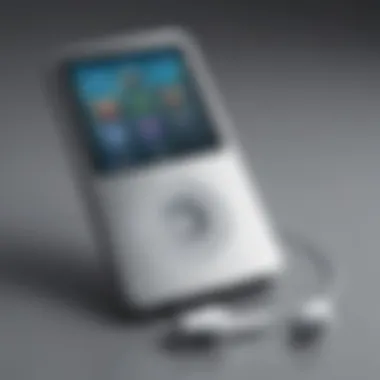Exploring the Least Expensive iPod Models Available Today


Product Overview
Preamble to the Apple product being discussed
Apple products have always been synonymous with innovation, and the iPod is no exception. iPods have played a critical role in shaping the portable music ecosystem since their initial launch in 2001. Today, we focus on exploring the least expensive options currently available. These models offer an enticing combination of functionality and affordability, catering to both casual listeners and more serious audiophiles.
Key features and specifications
The least expensive iPod typically includes:
- Compact Size: Easy to carry on the go.
- Storage Options: Varied storage depending on model, with some capable of holding thousands of songs.
- Audio Quality: Excellent sound delivery, making it appealing for music lovers.
- Battery Life: Optimized for long listening sessions without frequent charging.
Specific models may differ in extra features, like integration with Apple Music or Bluetooth connectivity, enhancing the audio experience further.
Design and aesthetics
Apple’s commitment to sleek designs is evident in these budget-friendly iPod models. The materials used often align with those of higher-end models, providing a premium feel. Choose from an array of colors to reflect personal style, providing individuality while maintaining the functional aspects of the device.
Performance and User Experience
Performance benchmarks
When considering performance, even the least expensive iPods showcase robust functionality. They often run the latest version of iOS software, facilitating smooth navigation and compatibility with current applications. However, more intensive tasks may present limitations.
User interface and software capabilities
The intuitive interface design allows users of all experience levels to navigate effortlessly. Features like the music library and playlists are easily accessible, contributing to a seamless user experience.
User experiences and feedback
Consumers have noted that these inexpensive options retain high audio quality and user-friendly interface. Frustrations often arise regarding processing speed and functionality limitations when compared to flagship models. However, many consider the trade-offs acceptable for the price point.
Comparison with Previous Models or Competitors
Advancements and improvements from previous models
Over the years, Apple has refined the iPod’s features significantly. Recent models show improvements in:
- Battery Efficiency: Longer listening times reached through better battery technology.
- Interface Upgrades: Enhanced connectivity options such as quick link to Apple Music.
Competitive analysis with other similar products
In a crowded market, the competencies of these models stand against competitors like SanDisk Clip Sport and Microsoft Zune. Key areas of focus in such comparisons usually include audio quality, user interface, and overall durability.
Value proposition
The cost-effectiveness of currently available iPods often makes them preferable for entry-level users. Their reliability combined with a solid feature set creates a solid value proposition that resonates well with financially-conscious buyers.
Tips and Tricks
How-to guides and tutorials for optimizing the Apple product's performance
To extend the life and usability of a budget iPod:
- Regularly Clear Music: Remove dormant tracks to free up storage.
- Update Software: Keeping software updated can improve functionality.
Hidden features and functionalities
These devices may include less obvious features, such as:
- Radio functionality.
- Support for voice commands (for compatible models), which can enhance usage.
Troubleshooting common issues
Performance lags can sometimes trouble users. A common solution is rebooting the device or resetting network settings, which tends to help alleviate software-related issues.


Latest Updates and News
Recent developments in software updates and new features
Regular software updates improve security and performance. Keeping an eye on Apple’s announcements is prudent to glance into potential new capabilities that could be added.
Industry news and rumors surrounding upcoming products
Speculation often surrounds future iPod releases or revitalizations. Rumors of a possible redesigned iPod touch have circulated, though an official confirmation is still pending.
Events and announcements from Apple
Apple often showcases innovations during annual events. Ignoring these can lead to missing vital updates regarding themselves or competitive products.
Therefore, while considering a budget-friendly iPod, understand its potential against other modern devices to make an informed decision for your specific needs.
Understanding the iPod Ecosystem
The iPod has played a significant role in shaping the way we consume music and media over the years. To fully comprehend the least expensive iPod on the market, it is necessary to explore the broader context of the iPod ecosystem. This ecosystem encompasses not only the device itself but also the advancements in technology, variations in models, and current market positioning by Apple.
Through examining the iPod ecosystem, readers gain insight into how these devices have evolved and why they remain relevant today. Understanding its evolution gives context to current offerings, paints a clearer picture of their features, and elucidates why consumers might still consider them over smartphones for dedicated music use.
The characteristics unique to the iPod go beyond mere consumer electronics; they create a lifestyle centered around aesthetic design, user experience, and interaction with music. Whether an avid music fan or an occasional listener, knowing what drives the appeal of the iPod aids potential buyers in making informed decisions based on personal needs.
The Evolution of iPod Models
Since its debut in 2001, the iPod has gone through various transformations. Each new model introduced distinct features and improvements, enhancing both functionality and user enjoyment. For instance, the original iPod established a foundation with its mechanical scroll wheel and unique styling. In contrast, the introduction of the iPod Mini and Nano showcased miniaturization and portability.
As music consumption shifted with the arrival of digital downloads and streaming services, Apple adapted the iPod to meet user demands. The iPod Touch emerged, providing access to apps and the internet, resembling a smartphone but focused more on media playback. Over time, the myriad of iPod models includes the Shuffle, Classic, Nano, and Touch, each serving different consumer preferences.
Reflecting on these changes reveals how the iPod became a cultural phenomenon more than a functional music player. Features evolved to keep pace with technological advancement while managing affordability without compromising core functions. Such expansions also bring clarity to what is available today in terms of budget devices.
Current iPod Offerings from Apple
Apple's approach to its current iPod lineup represents a streamlined focus on integrating their range of products more cohesively. Today, the range includes the iPod Touch as the sole surviving model in the family. By concentrating on one main device, Apple ensures that users receive a consistent experience devoid of unnecessary complications.
The iPod Touch remains contemporary through continual updates providing software capabilities often akin to that of an iPhone. Streamlining offerings allows Apple to theoretically reduce overheads, benefitting consumers seeking technology-rich, budget-friendly options.
Furthermore, examining the pricing strategies adopted for the iPod Touch enlightens discussions on value relative to its features. For those who want the quintessential Apple music experience minus the higher costs of full-fledged smartphone functionalities, the Touch stands out. At its core, it serves as an entry point for users who prefer the dedicated audio experience without distractions of phone features.
Why Choose an iPod in a Smartphone Era
Even in the current smartphone-centric environment, the iPod holds a unique place for its core functionality. The simplicity, portablity, and ease of use differentiate it from multifunctional handsets. Many music enthusiasts prefer dedicating their listening experience solely to music, and the iPod's focus aligns with that experience without additional distractions.*
Also, not everyone requires all the capabilities offered by an iPhone. For casual listeners or those with specific needs, the iPod can represent cost savings, where the limited functionalities reflect more relevant values. Additionally, while streaming services flourish, an iPod preloaded with music creates signed preferences and harnesses offline independence that might be limited on cellular networks.
In summary, choosing an iPod today transcends mere nostalgia. Its compact format, dedicated systems, and clear focus on audio lend it relevance in today's market, softering even the compelling offerings from top smartphone brands. Anyone considering their buying journey into iPods must consider the ecosystem that shaped preferences whether audiophile or casual with a unique enjoyment of curated playlists.
Identifying the Least Expensive iPod
Identifying the least expensive iPod is crucial for consumers who prioritize cost alongside functionality. With a variety of models on the market, it is essential to understand which ones offer the best balance between features and value. This segment explores market options and price comparisons to illustrate how the less costly iPods can meet users' needs effectively.
Current Market Options
As of now, Apple offers a limited range of iPir packaging, with models like the iPod touch continuing to capture interest. Even in a competitive smartphone environment, specific models have drawn attention for being budget-friendly.
The current iPod touch model often emerges as the most economical entry point into the iPod ecosystem. Considering its frequently updated architecture, including a robust processor and access to Apple Music and other features, it provides a compelling proposition. Currently, several retailers like Amazon for example, feature various storage capacity options, often around 32GB and 128GB.
Issues of affordability extend beyond the initial purchase price. Refurbished devices are available that may present as another option to save money. This approach can simultaneously increase accessibility for users unwilling to pay full price while providing the assurance of a dependable product.
Price Comparison with Other Media Players
In compaison to other media players available, the iPod models hold a specific niche. For instance, basic devices from companies like SanDisk or Sony offer music playback without some extensive capabilities that the iPod touch provides. In terms of features, the iPod, especially with its access to iOS, offers functionalities such as app-store access that appeal to a wider audience.
When we look at the pricce points, budget players are around $30-$70. However, they lack the dynamics and capabilities offered by most iPods. For example:


- iPod touch 32GB: Approximately $199
- SanDisk Clip Sport Plus: Around $69
- Sony Walkman NWZ-W273: About $98
Key Features of the Least Expensive iPod
Understanding the key features of the least expensive iPod models is crucial for anyone considering a purchase. Beyond just the price, these models reflect a balance of functionality, user experience, and technology trends. The analysis of these feature provides insight into what consumers can expect when selecting a budget-friendly audio device. By breaking down each aspect below, we get a clearer picture of the available models and their overall value. This synthesis of essential traits serves as a guide for tech enthusiasts and everyday users alike.
Audio Quality and Performance
Audio quality remains a cornerstone of any music-playing device, especially for an iPod. Despite its lower price, the least expensive iPod often delivers surprisingly robust sound quality. Apple tends to use decent DAC chips to ensure that audio output does not feel grainy or flat. Users should expect clarity in both highs and lows; this is especially noticeable when using good quality headphones.
Factors such as compression and the supported audio formats also play a role. For example, the iPod usually supports AAC, MP3, and WAV formats, providing flexibility based on the user’s music library. Reviews indicate that the least expensive models hold up well against other media players in terms of sound fidelity.
It is important to consider different listening environments too. An iPod may excel in quiet home settings as well as during commutes, supporting various user needs without sacrificing quality.
Storage Capacity Considerations
Storage capacity is another vital factor when evaluating the least expensive iPod. Many users may question whether basic storage options can meet their music consumption habits. The multiple capacities usually offered vary significantly, so knowing your own music library size is crucial. For casual listeners, 32GB could be more than enough, while dedicated audiophiles may lean towards larger capacities.
Interestingly, the integration of cloud services, like Apple Music or iTunes Match, transforms the approach to storage. Although the device holds a specific amount, enough songs can be streamed or stored elsewhere, lessening dependency on onboard storage.
A limitation to understand is that if users update to larger libraries over time, they may find the basic model quickly becomes insufficient. Therefore, familiarity with one's needs and a predilection for extra space may ease purchasing decisions.
Battery Life Expectations
Lastly, battery life must be dissucsed in the context of affordability and feature set. The least expensive iPod often has excellent power management, with typical use suggesting a range of 24 hours for audio playback. This longevity is engaging to casual listeners who would like less interuption when enjoying music.
However, various factors will affect performance. Features like Wi-Fi connectivity or continuous playback of high-quality audio can draw more power. Delving into user reviews might provide a range of battery experiences; while some find the lifespan impressive, others could run into quicker depletion in specific scenarios.
To conserve battery, many users opt to adjust brightness or use offline playlists, balancing usability with energy needs. Additionally, charging considerations must play a role; cheap and accessible solutions exist for those frequently on-the-go.
In summary, assessing audio quality, storage capacity, and battery life helps illuminate the value offered by the least expensive iPods. In a market saturated with alternatives, these features can distinctly influence a user decision.
User Experience with iPods
User experience plays a central role when discussing iPods, notably the least expensive models, which are pivotal in the choice of consumers today. Factors like usability, simple design, and overall efficiency can make or break the purchaser’s satisfaction. The affordability of iPods brings diverse users into the ecosystem – from casual listeners to more discerning audiophiles. Understanding their experiences illustrates how digital music solutions align with their expectations.
Design influence shines through; it interconnects technology and user desires. This relationship provides insight into preferences for sound quality and features against price points.
Usability and Interface Design
iPods offer a range of features wherein usability depends heavily on an intuitive interface design. Apple has consistently aimed to create user-friendly devices. This ensures users, even those less tech-savvy, engage effortlessly with their devices. Menus are notable for their straightforward layout which eases navigation. For instance, the recent iPod Touch leverages a tactile experience with a user interface that mimics the broader iOS ecosystem, providing familiarity.
Key usability considerations include:
- Responsiveness: The device reacts quickly to touch, eliminating frustrating delays in accessing music.
- Physical Controls: Simple hardware buttons enhance usability quickly when browsing songs or charging.
- Accessibility: VoiceOver and other features ensure that individuals with disabilities can use these devices with comfort.
Overall, the interface design allows for customization while remaining naturally appealing, bridging varied levels of user familiarity with smartphones and basic MP3 players.
Community Feedback and Reviews
Feedback from the community continues to be a strong testament to user experience. Online forums and reviews represent a vibrant dialogue among consumers. Platforms like Reddit feature in-depth discussions regarding specific iPod models and consumer satisfaction. Reviewing genuine feedback provides insights into satisfaction and pain points across diverse use cases.
Here are common themes seen in various reviews:
- Sound Quality: Users often commend the robust audio quality that Apple maintains across its products.
- Durability: Frequent mention of the sturdiness cycles between satisfaction and slanting hurtful when discussing price versus functionality delayed over years.
- Battery Life: Consistent positive feedback is centered around lasting battery performance, enabling users to maintain music playback into their commuting or travel experience.
Those seeking genuine opinions can explore dedicated threads on Reddit or Apple's community support forums for a well-rounded understanding of how users are experiencing their devices day-to-day.
“User experience encapsulates not just a device's performance but how it fits into our lifestyle. That value determines both joy and frustration in usage.”
Purchasing Options
Purchasing an iPod, especially the least expensive models, requires understanding various options available in the market. This decision not only hinges on cost but also factors like value and condition. Increasingly, consumers are looking for smart choices, weighing the benefits of buying new against options for refurbished devices.
Where to Buy


Finding the right venue for purchasing an iPod can drastically impact your overall satisfaction and value. Here's a concise analysis of key places to consider:
- Official Apple Store: The most autoritative source for new iPods. Apple ensures quality and provides solid customer service.
- Authorized Retailers: Certain electronic retail chains may offer competitive prices or bundles. Chain stores like Best Buy typically carry several models.
- Online Marketplaces: Websites such as Amazon or eBay allow for additional price comparison. While the prices may be lower, it's important to consider seller ratings and product condition carefully.
- Local Listings: Using platforms like Craigslist or Facebook Marketplace can uncover excellent deals from individual sellers. However, buyer caution is advised.
It's critical to validate sellers and seek their return policy, which protects buyers against post-purchase discontent.
New vs.
Refurbished iPods
The choice between selecting a new or refurbished iPod is complex. Both variants serve the same fundamental purpose but require a diligent consideration of pros and cons.
New iPods
- Warranty Assurance: New devices typically come with a full warranty covering defects.
- Latest Models: Purchasing new gives access to the most current models featuring newer technology.
- Pristine Condition: With new units, condition is guaranteed.
Refurbished iPods
- Cost Savings: Refurbished iPods usually carry a lower price, a significant draw for budget-conscious users.
- Certified Quality: Many are certified by either Apple or reputable third-party firms; this means they have met quality standards after scrutiny and repairs.
- Sustainability Impacts: Buying refurbished also means participating in an eco-friendly initiative by extending the life cycle of a product.
It’s essential to scrutinize the conditions and market offers fully to avoid pitfalls related to inferior products or misleading discounts.
Balancing personal preferences with budgetary limits will be the driving force of this purchasing decision.
Considerations Before Buying
Before making the decision to purchase the least expensive iPod, it's vital to carefully evaluate several key factors. In this section, we will emphasize the importance of assessing your unique needs, budgeting comprehensively, and understanding how these considerations impact the overall value of your investment. An informed decision can lead to a fulfilling music experience, making it essential to contemplate elements beyond just the cost of the product.
Assessing Your Needs
When considering an iPod, understanding your specific requirements is fundamental. Each individual may prioritize different features, which can greatly influence the choice of model. Are you primarily interested in audio quality, storage capacity, or a particular form factor?
Key Questions to Guide Your Assessment:
- Purpose: Do you want an iPod mainly for music playback, podcasts, or audiobooks?
- Music Collection Size: How extensive is your music library? This directly impacts the storage capacity you should opt for.
- Use Cases: Will you use the iPod on the go, or will it primarily serve as a stationary device?
Determining these aspects allows for a tailored approach to purchasing. For instance, someone who visits the gym for workouts may prioritize a lightweight model with reliable sound quality, whereas a casual listener may find little value in features like Wi-Fi connectivity.
Budget Considerations Beyond Purchase Price
Establishing a budget is only one part of the purchasing equation. It is critical to examine other financial aspects associated with owning an iPod. The initial cost may be low, yet other ongoing or hidden expenses can add up.
Areas to Consider:
- Accessories: Quality headphones, cases, or additional charging equipment may be needed. These, too, can multiply costs.
- Content purchases: Subscriptions to music services or paid downloads can increase the average cost of ownership.
- Potential repairs or replacement: Low-end devices may come with shorter lifespans, meaning repairs may become necessary or replacements could occur sooner.
Holistic budgeting is vital in this context. Knowing how additional expenditures will affect your finances ensures a smoother and more satisfying experience as an iPod user.
Future of the iPod
Understanding the future of the iPod is essential in appreciating where this iconic device could be headed in a rapidly changing tech landscape. As mobile devices evolve, the relevance and purpose of iPods constantly come into question. This section explores various aspects that could influence the future trajectory of the iPod.
Trends in Personal Music Consumption
Trends in personal music consumption are shifting, influenced by technology and user behavior. Streaming services dominate how users access music. With platforms like Spotify and Apple Music, the demand for dedicated music players has decreased. However, there remains a niche audience that values simplicity and curated experiences. Many still enjoy having a device that is solely for music, separate from their phones.
The resurgence of portable audio and high-resolution music formats may play a role in the resurgence of specific iPod models. Especially among audiophiles looking for better sound quality than what mobile phones typically offer, dedicated music players offer clear advantages.
Key points to consider in this trend include:
- The growth of niche music markets
- Increased interest in music quality
- Continued appetite for dedicated music devices among certain demographics
Apple's Strategic Direction
Apple's strategic direction is crucial in determining the future of the iPod. In recent years, Apple has merged many iPod functions into the iPhone and has focused heavily on services. That said, it has the ECG potential to pivot back and focus on standalone devices, based on varying consumer interests and feedback.
The company's approach to market segmentation influences how it decides to develop the iPod further. Changes couldbe based on class of user, price sensitivity, and overall market demands. The continued success of their streaming platform suggests that a specialized device could find its place in a specialized market with specific needs.
Apple's ability to adapt to changing consumer behavior will determine the future success or decline of the iPod brand.
Understanding Apple’s pathway includes observing its commitment to innovation. The industry is highly dynamic, and Apple has a history of capitalizing on emerging trends to maintain relevance. The repeated consideration of how standalone devices like an iPod fit within Apple's overarching service strategy can provide insight into the brand’s future focus.
To summarize, the future of the iPod will ultimately depend on how it aligns with music consumption trends and Apple's ongoing evolution in strategy. Factors like audiophile needs and cycles of new innovations can significantly shape its next steps.



